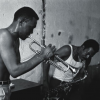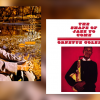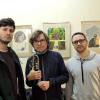Home » Jazz Musicians » Ornette Coleman
Ornette Coleman

Early on in his career, alto saxophonist Ornette Coleman, recorded an album entitled, The Shape of Jazz To Come. It might have seemed like an expression of youthful arrogance - Coleman was 29 at the time - but actually, the title was prophetic. Coleman is the creator of a concept of music called "harmolodic," a musical form which is equally applicable as a life philosophy. The richness of harmolodics derives from the unique interaction between the players. Breaking out of the prison bars of rigid meters and conventional harmonic or structural expectations, harmolodic musicians improvise equally together in what Coleman calls compositional improvisation, while always keeping deeply in tune with the flow, direction and needs of their fellow players. In this process, harmony becomes melody becomes harmony. Ornette describes it as "Removing the caste system from sound." On a broader level, harmolodics equates with the freedom to be as you please, as long as you listen to others and work with them to develop your own individual harmony.
For his essential vision and innovation, Coleman has been rewarded by many accolades, including the MacArthur "Genius" Award, and an induction into the American Academy of Arts and Letter. an honorary doctorate degree from the University of Pennsylvania, the American Music Center Letter of Distinction, and the New York State Governor Arts Award.
But the path to his present universal acclaim has not always been smooth.
Born in a largely segregated Fort Worth, Texas on March 9, 1930, Coleman's father died when he was seven. His seamstress mother worked hard to buy Coleman his first saxophone when he was 14 years old. Teaching himself sight-reading from a how-to piano book, Coleman absorbed the instrument and began playing with local rhythm and blues bands.
In his search for a sound that expressed reality as he perceived it, Coleman knew he was not alone. The competitive cutting sessions that denoted 'bebop' were all about self-expression in the highest form. "I could play and sound like Charlie Parker note-for-note, but I was only playing it from method. So I tried to figure out where to go from there," Coleman said.
Los Angeles proved to be the laboratory for what came to be called free jazz. There began to gather around Ornette a core of players who would figure largely in his life: a lanky teenage trumpeter, Don Cherry and a cherubic double bass player with a pensive, muscular style named Charlie Haden, drummers Ed Blackwell and Billy Higgins also joined the intense exploratory rehearsals in which Coleman was honing his vocabulary on a plastic sax, despite the lack of live gigs.
Read moreTags
Deconstructing Free Jazz

by Robert J. Lewis
In the continuously evolving history of artistic expression, certain movements emerge that challenge the very foundations of our aesthetic sensibilities. In the early and mid-20th century, Expressionism and free jazz were two audacious musics that not only broke all the rules but broke the spirit of many well-intentioned listeners. If the terms are not quite interchangeable, Expressionism and free jazz share a common genesis that goes back to the early 20th century with the introduction of the 12-tone ...
Continue ReadingOrnette Coleman's and Horace Silver's "Lonely Woman" — A Disambiguation

by Artur Moral
Reality is filled with confusion and misunderstandings; some are suggestive or creative, while others are disappointing or, worse, malicious. The jazz world is no stranger to the first type: specific compositions are often confused or misidentified as if they were the same. Usually, this happens because of similar melodies or titles that are sometimes identical. This last case applies to the two themes discussed here, which are homonymous but musically quite different. The first, desolate and raw, is by Ornette ...
Continue ReadingOrnette Coleman: Free Jazz to Ornette! Revisited

by Alberto Bazzurro
Che cosa si può dire ancora di un'opera che ha stravolto il corso del jazz, uno di quegli snodi dopo i quali--qui fin dal titolo--nulla può essere più come prima? Punti di svolta decisivi e ineludibili che cambiano il corso di un'arte, pietre miliari come Les Demoiselles d'Avignon in pittura, l'Ulysses di Joyce in letteratura, o più specificatamente in poesia Un coup de dés di Mallarmé? Nulla, appunto, perché tutto dev'essere per forza di cose già stato detto e scritto, ...
Continue ReadingOrnette Coleman: Free Jazz To Ornette! Revisited

by John Eyles
For ezz-thetics' revisited series' fourth Ornette Coleman album, the label has ventured back further than any of its previous Coleman albums, to New York City in December 1960 and January 1961. Recorded at A&R Studios on Wednesday December 21st 1960 from 8pm to 12.30am, the Free Jazz session produced two pieces, the thirty-seven minute “Free Jazz" itself, which was issued in September 1961 on an Atlantic album entitled Free Jazz: A Collective Improvisation By The Ornette Coleman Double Quartet, and ...
Continue ReadingOrnette Coleman: At The Golden Circle Stockholm Revisited

by Stefano Merighi
Ritornare a certe “opere aperte" di Ornette, come questo notissimo concerto di Stoccolma della fine del 1965, significa ribadire l'alterità irriducibile del maestro texano, che sarà stato sì come si legge sempre nella manualistica mainstream l'inventore del free jazz eccetera, il killer della tradizione, il primitivo con il sax di plastica, ma soprattutto un mago dell'istinto, un poeta della musica come flusso chimico naturale, i cui esiti hanno sempre parlato all'ascoltatore con intenti inclusivi, puntando alla libertà del linguaggio come ...
Continue ReadingOrnette Coleman Trio: At The Golden Circle Stockholm Revisited

by John Eyles
As the ezz-thetics label has already released two of Ornette Coleman's Blue Note albums together on New York Is Now & Love Call Revisited, both recorded in April and May 1968, it was always in the cards that both volumes of At the Golden Circle Stockholm, recorded in December 1965, would not be far behind. Sure enough, here they are, both together on one disc with a running time of eighty minutes. That means this single disc includes all of ...
Continue ReadingOrnette Coleman: An Innovator of the First Order, But Certainly No Messiah

by Richard J Salvucci
At the remove of sixty years, there is a temptation to say, “Ornette Coleman, so what?" His early music does not sound particularly out there. And by contemporary standards, it is not. The initial shock of Ornette Coleman in the mid 1950s wore off decades ago. Some of his compositions have passed into the standard repertoire. Coleman may have been a founding member of the Free Jazz Movement, but Cecil Taylor and Albert Ayler among others, moved beyond abandoning Western ...
Continue ReadingJazz Musician of the Day: Ornette Coleman

Source:
Michael Ricci
All About Jazz is celebrating Ornette Coleman's birthday today!
Early on in his career, alto saxophonist Ornette Coleman, recorded an album entitled, The Shape of Jazz To Come. It might have seemed like an expression of youthful arrogance- Coleman was 29 at the time- but actually, the title was prophetic. Coleman is the creator of a concept of music called “harmolodic," a musical form which is equally applicable as a life philosophy. The richness of harmolodics derives from the unique ...
read more
Jazz Musician of the Day: Ornette Coleman

Source:
Michael Ricci
All About Jazz is celebrating Ornette Coleman's birthday today!
Early on in his career, alto saxophonist Ornette Coleman, recorded an album entitled, The Shape of Jazz To Come. It might have seemed like an expression of youthful arrogance- Coleman was 29 at the time- but actually, the title was prophetic. Coleman is the creator of a concept of music called “harmolodic," a musical form which is equally applicable as a life philosophy. The richness of harmolodics derives from the unique ...
read more
Jazz Musician of the Day: Ornette Coleman

Source:
Michael Ricci
All About Jazz is celebrating Ornette Coleman's birthday today!
Early on in his career, alto saxophonist Ornette Coleman, recorded an album entitled, The Shape of Jazz To Come. It might have seemed like an expression of youthful arrogance- Coleman was 29 at the time- but actually, the title was prophetic. Coleman is the creator of a concept of music called “harmolodic," a musical form which is equally applicable as a life philosophy. The richness of harmolodics derives from the unique ...
read more
Jazz Musician of the Day: Ornette Coleman

Source:
Michael Ricci
All About Jazz is celebrating Ornette Coleman's birthday today!
Early on in his career, alto saxophonist Ornette Coleman, recorded an album entitled, The Shape of Jazz To Come. It might have seemed like an expression of youthful arrogance- Coleman was 29 at the time- but actually, the title was prophetic. Coleman is the creator of a concept of music called “harmolodic," a musical form which is equally applicable as a life philosophy. The richness of harmolodics derives from the unique ...
read more
Jazz Musician of the Day: Ornette Coleman

Source:
Michael Ricci
All About Jazz is celebrating Ornette Coleman's birthday today!
Early on in his career, alto saxophonist Ornette Coleman, recorded an album entitled, The Shape of Jazz To Come. It might have seemed like an expression of youthful arrogance- Coleman was 29 at the time- but actually, the title was prophetic. Coleman is the creator of a concept of music called “harmolodic," a musical form which is equally applicable as a life philosophy... Read more.
Place our Musician of the Day ...
read more
Jazz Musician of the Day: Ornette Coleman

Source:
Michael Ricci
All About Jazz is celebrating Ornette Coleman's birthday today!
Early on in his career, alto saxophonist Ornette Coleman, recorded an album entitled, The Shape of Jazz To Come. It might have seemed like an expression of youthful arrogance- Coleman was 29 at the time- but actually, the title was prophetic. Coleman is the creator of a concept of music called “harmolodic," a musical form which is equally applicable as a life philosophy... Read more.
Place our Musician of the Day ...
read more
The Free Soul of Ornette

Source:
JazzWax by Marc Myers
Abstraction came late to jazz. New York's abstract expressionism art movement emerged in the late 1940s and flourished throughout the 1950s. By contrast, free jazz didn't coalesce until the late 1950s, though there were inklings of the style in the music of Lee Konitz in the late 1940s and early '50s. Not until alto saxophonist Ornette Coleman and his sidemen did free jazz begin to become a jazz genre in 1959. While the music can be difficult for listeners accustomed ...
read more
Jazz Musician of the Day: Ornette Coleman

Source:
Michael Ricci
All About Jazz is celebrating Ornette Coleman's birthday today!
Early on in his career, alto saxophonist Ornette Coleman, recorded an album entitled, The Shape of Jazz To Come. It might have seemed like an expression of youthful arrogance- Coleman was 29 at the time- but actually, the title was prophetic. Coleman is the creator of a concept of music called “harmolodic," a musical form which is equally applicable as a life philosophy... Read more.
Place our Musician of the Day ...
read more
Jazz Musician of the Day: Ornette Coleman

Source:
Michael Ricci
All About Jazz is celebrating Ornette Coleman's birthday today!
Early on in his career, alto saxophonist Ornette Coleman, recorded an album entitled, The Shape of Jazz To Come. It might have seemed like an expression of youthful arrogance- Coleman was 29 at the time- but actually, the title was prophetic. Coleman is the creator of a concept of music called “harmolodic," a musical form which is equally applicable as a life philosophy... Read more.
Place our Musician of the Day ...
read more
Ornette Coleman, Traditionalist

Source:
Rifftides by Doug Ramsey
There will be a funeral service for the saxophonist, composer, bandleader and iconoclast Ornette Coleman in Manhattan at 11 o’clock tomorrow morning, June 27. Coleman died on June 11 at the age of 85. Rifftides noted his passing that day. The service at The Riverside Church, between W. 122 St. and W. 120 St., will be open to the public. Thoughts of Coleman took me to a day in the 1960s not long after the release of his album Free ...
read more































































































































































